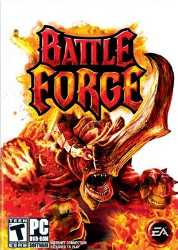
Before being acquired by Electronic Arts in 2006, German studio Phenomic created SpellForce, a series of real-time strategy games with RPG elements. Their first project as an EA subsidiary is BattleForge, a more peculiar hybrid: a real-time strategy/collectible card game. The result is a very unique experience in the RTS genre but its unusual structure also comes with its own set of peculiar issues.
Before anything else is said about the game, it's worth mentioning that BattleForge is an online-only game. You'll need to log onto the game's servers to even play the single-player missions. Playing on your own isn't all that appealing, either; the campaign's storyline is conveyed through voiceover and pages of text so it's really tough to get into. It's tough for me to judge the story on its merits because it's told in such a unengaging manner and frankly I've already forgotten it.
Fortunately, many missions in the campaign will require you to play alongside another player (or three or eleven) which is interesting because in most real-time strategy games, the only time you get to play alongside another human is in PvP skirmishes. The game offers up some interesting scripted challenges for you and your comrades. In one early map, you and another player are separated by a mountain range and must move north and clear enemy forces from your respective halves of the map. There's a catch, though: enemy reinforcements will stream down from the enemy base at the top of the map. You and your partner must use a magical force field to stop the reinforcements from attacking - but only one half of the map can be blocked from reinforcements at a time. Thus, you have to take turns defending against reinforcements while the other player advances up his side of the map.
The problem with playing alongside another player though is that you have to rely on this other person, who might just be some random stranger that the game's lobby system set you up with. I haven't played a 12-player scenario but can imagine the odds are slim that the game will randomly match you up with 11 level-headed players. In the two-player scenario I previously mentioned, my partner struggled and I had to sit idly by with my half of the map cleared and watch him fumble around for the next fifteen to twenty minutes until his half was cleared and we could finally move on to destroy the last enemy stronghold together. The game randomly awards upgrade cards to players in the party after a match and, by a cruel twist of fate, deemed my inept partner worthy of three of the four cards. It's the sort of thing that drives one straight to the PvP duels that the game also offers.
In most real-time strategy games, you must construct a base in order to produce units. In BattleForge, you create units by playing one of twenty different cards in your deck. You can play cards more than once but you're restricted by how much power and how many orbs you have. Power is a spendable resource you accumulate by capturing certain points of the map and building power wells. Orbs are acquired in much the same way (by building "monuments" instead of power wells) but you don't spend them and they're much more rare. While power determines how many units you can summon at given time, orbs determine what type of units you can summon. You'll start with one orb and be able to only summon low-level units but once you get to four orbs, the mightiest units in the game will be at your disposal. Units are created instantly and can be summoned within a small radius of your monuments/power wells or next to any of your units, though the latter option will result in the unit being weakened for a brief period of time.
The game's deviations from the normal real-time strategy structure have profound effects. Other than your power wells, monuments, and the occasional support structure (turrets mainly), you don't have a "base". Instead of building one massive fortification in the corner in the map with all the structures you need, you're forced to spread yourself across the map to control more orbs and get more advanced units. Being able to summon units in the field by simply clicking one of the cards lined up at the bottom of your screen and then placing them on the map makes battles much quicker, too. Instantly conjuring up an army does result in battles becoming something of a spam-fest, though, with players just throwing more and more units on top of each other. It's about as strategic a five-year-old pushing two piles of green army men together.
BattleForge is a fast-paced game because the real micromanagement takes place between matches. There's 200 cards (units, spells, and support structures) usable by players and they're spread over four sets: Shadow, Nature, Fire, and Frost. The units for each of these elements each have a distinct look and style. Frost, for example, tends to have more defensive units. All of these units look fantastic, by the way, especially the higher-level stuff like dragons. While you can build a 20-card deck solely from one element, you can also mix-and-match the elements. The game allows you to save many custom decks and even gives you a little practice area called the Arena where you can pit your forces against A.I. enemies to test out their strength. The massive amount of units available in the game means that there's a lot more research than most real-time strategy games.
Your Daily Blend of Entertainment News
Yep, research. Takes more money than other games, too. To expand your deck, you'll need to buy booster packs with eight random cards. These booster packs cost BattleForge Points, which in turn cost real money. A booster pack costs 250 BattleForge Points ($2.50, I believe) but you get 3000 points free with a copy of the game so you can build up a pretty substantial deck without paying a dime. Completing missions will get you upgrade cards and gold, both of which you put toward strengthening your units so improvement isn't merely based on how much money you pour into the game. You can sell/buy cards through the in-game auction house as well so it's possible to earn some BattleForge Points by shedding your duplicates, though only the rare cards will actually sell.
The upgrade system and premium cards might keep each other in check but together they disrupt a fundamental characteristic of real-time strategy games: balance. While I doubt an imbecile with the best cards will automatically destroy an experienced player who hasn't shelled out any extra money on the game, the fact is that matches will be unbalanced when they begin. Also take into consideration the fact that it's basically impossible to balance every 20-card combination against every other 20-card combination in the game. You could walk into a match with a deck that's completely awful against your opponent's deck or vice versa; neither scenario is all that much fun.
The game could end up picking up a small, dedicated following but the die-hards are more likely going to be fans of collectible card games than real-time strategies. Though on the surface BattleForge is a real-time strategy game, it's a collectible card game at its heart and to like the game you'll need to enjoy the collection, research, and other preparation work of CCGs.
Players:1-12 players
Platform(s):PC
Developer:EA Phenomic
Publisher:Electronic Arts
ESRB:Teen
Rating:

TestFreaks: 7.4/10 MetaCritic: 7.4/10 GameRankings: 7.2/10
Staff Writer at CinemaBlend.

